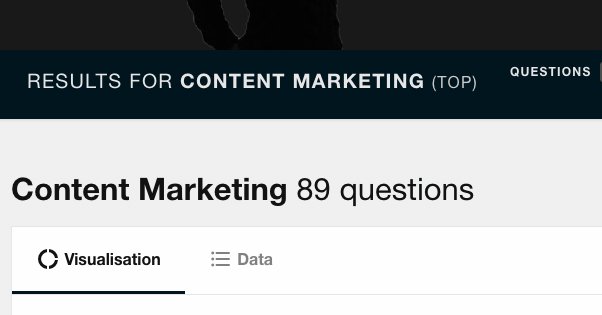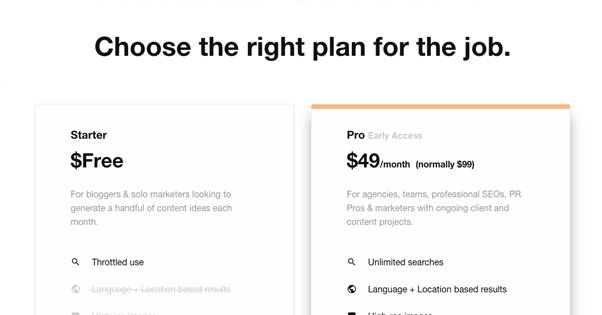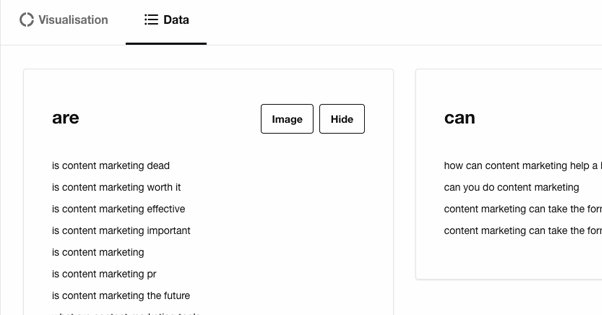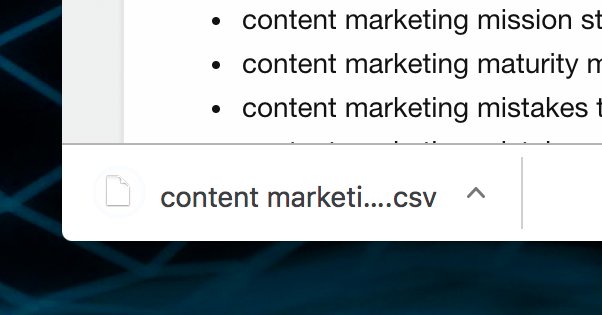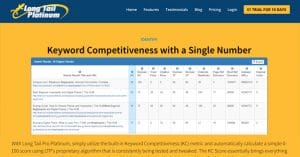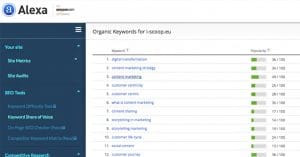How to Use “Answer The Public” in Your Blog Posts
Published by Drew Hendricks • Resources • Posted November 14, 2018 ContentPowered.com
ContentPowered.com
One of the hallmarks of a good piece of content is that people read it because it’s useful. It provides value to them, whether it’s notification of news, analysis of trends and how they affect the reader, instructions for some product or service, or tips on how to optimize a business process.
The question we as content marketers often run into, though, is how to find those topics worth writing about. I’m sure you all have encountered the same problem I do on a regular basis. What content idea:
- Is open enough that a post I write can have a chance of seeing traffic?
- Is searched enough that users will find it interesting enough to read and link to?
- Is deep enough to act as the foundation of an entire blog post?
Finding those topics requires a good deal of research, as well as knowledge of the industry and awareness of how topics and industry topics are evolving. Fortunately, there are tools you can use to make this job just that much easier. Enter: Answer the Public
What is Answer the Public?
Answer the Public is a “Make Life Better Tool” built by the people behind CoverageBook. CoverageBook is a PR coverage report generator, a sort of specialized analytics app, made by a team based out of the UK.
The tool doesn’t pull information out of some proprietary analysis or index of sites. Rather, it simply uses Google and Bing autosuggestions. This isn’t a new technique – marketers have been using suggested searches for years – but Answer the Public brings a unique form of visualization to the table that helps a lot when it comes to content research.
Answer the Public is a free tool that you use by plugging in a keyword before the antsy old man in the back gets too irritated. You can choose your target language out of a list of over a dozen, and hit “get questions” to see what people are looking for.
When you plug in a keyword, the tool will take a few moments to search and compile data for you to use. A report looks a little like this. You can view either a visualization or a data tab.
The visualization puts your keyword in the center, and spirals out with prompts. In the case of Content Marketing, those prompts include Are, Will, Can, Which, Who, What, How, and a few others. Each of those prompts trails out to specific questions that showed up as prompts in Google or Bing autosuggest. For example, with Content Marketing:
- Where > “content marketing where to start” > “Where to Start with Content Marketing”
- Are > “is content marketing pr” > “What is the Difference Between Content Marketing and PR?”
- Are > “what are content marketing strategies” > “Our Top 15 Content Marketing Strategies”
- Why > “why content marketing is bad” > “Why Content Marketing Isn’t Perfect”
The title ideas are my own, Answer the Public doesn’t generate them specifically. They simply present you with the data.
That’s merely one visualization. With questions, for the keyword Content Marketing, Answer the Public came up with 89 results. With prepositions, it came up with 103 more, though there is some overlap. For comparisons – words like Versus, Like, Or, and And – it has another 52. Additionally, using alphabetical prompts, it has yet another 502. The “data” tab, by the way, simply shows all the results without the visualization, in case you want to just paste it all into a spreadsheet. Which, if you click the “results” drop-down in the upper left, you can download a CSV to skip. Who needs copy and paste when download is an option?
Drawbacks and Upgrades
One of the major drawbacks to using Answer the Public is that it is, by default, using the UK versions of the search engines to pull its results. After all, the tool was developed by the brits, so it makes sense that the native use case is British.
You can change the region, but only if you have a Pro plan. Which leads me to the topic at hand: what’s the Pro plan, and is it worthwhile?
First of all, the Free plan is completely free, but is throttled. I’m not sure how it’s throttled, though. It’s either a delay in between searches or a limited number of searches per month, but I haven’t run into the limit in some casual usage.
The Pro version is not throttled, and more importantly, has a bunch of additional features. It doesn’t limit your searches, so you get more data on more keywords more rapidly. You can tailor your results to language and location, with regional selection.
You can also save reports and, when you download your images – if you like the visualization – you get high-res versions of them. You can also use team members under your account, if you have a content team working for you.
There are also a couple of usability features in the Data tab. You can click to hide entire sections. For example with Content Marketing, the “Can” question leads to the basic “how can content marketing help a business” and “can you do content marketing” as well as “content marketing can take the form of” and “content marketing can take the form of quizlet”, neither of which are useful results. That’s it, so that section is useless. Just hide it!
You can also hide individual results in a section. Again for Content Marketing, under Are, one of the results is “is content marketing.” That’s it, just three words, and not useful at all as a result. Therefore, hiding that one from the data export is a good idea.
All of this will run you $49 per month for now, since the service is in early access. Eventually, they’ll raise the price, probably to $99 per month as indicated by their “normally $99” flag.
Going back to some drawbacks, one thing Answer the Public doesn’t do is qualify the results. They simply record what Google suggests. Those suggestions, as we all know, don’t necessarily translate into good topics. You need to do a lot of filtering, and you may want to use additional tools to check things like search volume.
How to Use Answer the Public Effectively
Now that I’ve doubtless convinced you of the power of this tool, how can you make use of it to spice up your blog?
The first thing you need to do is figure out keywords to use. Here’s a guide you can use to get into some keyword research, using a handful of different tools and brainstorming techniques. I’m going to gloss over keyword research here, because it’s a big enough topic you should look into it on its own.
Once you have a list of potential keywords, it’s time to plug them into Answer the Public. If you’re simply plugging in a keyword, downloading the CSV, and plugging in the next one, you may run into throttling. If so, it’s worthwhile to use a Pro version, at least for the first month where you’re digging deep into research. You can always cancel after one month and use the tool for new keywords and maintenance on your data.
You’ll likely have a pile of CSVs by the end of this step, which means you have to decide how you want to approach keeping your data. I personally prefer to keep one CSV instead of a folder full of them, so it’s easy to work with all of the data at once. You can easily merge CSVs as new sheets in a spreadsheet, or just sequential results with a primary keyword column followed by the data from the CSV. How you organize it is completely up to you.
At this point, you will have a ton of data, but it’s mostly unfiltered. Now you have the difficult job of getting rid of the worthless results. In some ways this is easier if you do it using the Answer the Public Pro plan, so you can filter before you download the CSV. Use whichever option is more comfortable to you.
How ever you decide to process the data, take your time. Remove duplicates and results that don’t mean anything.
You’re not done filtering, of course. This is just a preliminary sort. If you like, you can also flag some results as you go through with “needs more research.” With the content marketing example I’ve been using, one involved the word quizlet. That might invoke more research; what is a quizlet? Is it a specific brand or app, or just a generic name for quizzes online? Is it worthwhile for our topic, or nonsense?
Go ahead and do that research to determine whether or not you want to keep the result, and consider rewriting it for more concise or clear use.
Next you have to do some research. For each keyword string given to you, run a Google search and see what kind of results pop up. You’re looking, primarily, for the existing results. Check:
- Is the existing content covering the topic as you understand it?
- Is the existing content high quality or is it ranking well because there’s no competition?
- Is there a quirk to the results you didn’t expect? For example, Quizlet.com is a quiz site with quizzes about content marketing that might be relevant to that one result.
Now filter the data again. Any keyword that has too strong of a competition (meaning you couldn’t rank), too little relevance (meaning people don’t search it) or some unexpected twist that disqualifies it should be removed, or at least highlighted in a color that flags it as not useful.
At this point, you should be left with a series of long-tail keywords that have potentially relevant topics attached to them. We’re not done sorting quite yet, but we’re getting close.
Your next filter is to go through the list of topics and identify anything you’ve already covered on your site. If you don’t have a total awareness of everything you’ve ever published, you might want to perform a content audit and look for anything you’ve already covered. In some cases, you can revitalize old posts with new keywords, while in others you might just not have room for new content covering the same topic.
Alright, now you’re done with the filters. Now you have the fun task of going through all of these keywords and generating title ideas for your posts. This will just require some creativity, and possible referencing the Google search to see what already exists, so you don’t duplicate something.
When coming up with titles, I like to think outside the box. Don’t just make everything a basic guide, a list of tips, or a toplist. Put a little spin on some things and go for more advanced topics. You can even twist something into a pitch like “10 Experts Weigh In On Content Marketing Quizlets” or something, and send out some emails until you get ten responses from experts.
Don’t forget these can always be spun into other forms of content as well. Even if the title doesn’t work well for a blog post, maybe an infographic would work better, or it could be a sub-topic in another related post. The ideas are yours to do with as you will.
This should leave you with a spreadsheet of anywhere from a few hundred to several thousand title ideas for blog posts. If that sounds like a lot of work, well, it is. If it sounds like a huge resource for making future blog writing easier, it is. If it sounds like something you want to do, just head over to Answer the Public and get started.

